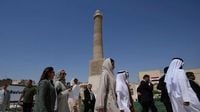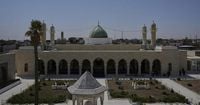On Monday, September 1, 2025, a significant chapter in Iraq’s cultural and religious history was reopened—literally—as the al-Nuri Grand Mosque and its famed leaning minaret in Mosul’s Old City welcomed visitors for the first time in eight years. The event, presided over by Iraq’s Prime Minister Mohammed Shia al-Sudani, marked not just the restoration of an architectural icon but also a powerful symbol of the city’s—and the nation’s—resilience in the face of devastation wrought by the Islamic State group (IS).
For centuries, the al-Nuri Grand Mosque’s minaret, affectionately known as al-Hadba (“the hunchback”), defined Mosul’s skyline. According to Sky News and Arab News, the minaret stood for approximately 850 years, serving as a proud testament to the city’s rich heritage. But in 2017, as IS militants faced defeat in a bloody battle with Iraqi military forces, they detonated explosives that leveled both the mosque and its iconic tower. The move was as much a tactical act of retreat as it was a symbolic blow, erasing a structure that, only three years earlier, had been the site where IS leader Abu Bakr al-Baghdadi declared the so-called “caliphate” by delivering a Friday sermon and leading prayers.
The destruction of al-Nuri was more than the loss of bricks and mortar. It was, as Prime Minister al-Sudani put it during the reopening, a wound to Mosul’s—and Iraq’s—soul. “The reconstruction of the mosque will remain a milestone, reminding all enemies of the heroism of Iraqis, their defense of their land, and their rebuilding of everything destroyed by those who want to obscure the truth,” al-Sudani declared, according to AP and Sky News. He added, “We will continue our support for culture, and efforts to highlight Iraqi antiquities, as a social necessity, a gateway to our country for the world, an opportunity for sustainable development, and a space for youth to innovate.”
The effort to bring al-Nuri back to life was no small feat. UNESCO, the United Nations’ scientific, educational, and cultural organization, played a pivotal role. Working hand-in-hand with Iraqi heritage experts and Sunni religious authorities, they painstakingly reconstructed the minaret using traditional techniques and materials salvaged from the original rubble. The project, which cost $115 million, was funded largely by the United Arab Emirates and the European Union, as reported by Arab News and Sky News. This collaboration not only ensured historical authenticity but also signaled a rare moment of international unity in support of Iraq’s cultural revival.
Yet the scope of the restoration extended beyond the mosque itself. As part of the same initiative, war-damaged churches across Mosul were also rebuilt, aiming to preserve the heritage of the city’s shrinking Christian population. It’s a sobering reality: before the IS offensive in 2014, Mosul’s Christian community numbered around 50,000. Today, fewer than 20 families remain as permanent residents, though some who resettled in northern Iraq’s Kurdish region return for church services. The exodus was fueled by IS’s campaign of terror, which, as Sky News and AP detail, included war crimes against Christians: property seizures, sexual violence, enslavement, forced conversions, and the destruction of cultural and religious sites.
The reopening of al-Nuri and the restoration of churches thus stand as a testament to Mosul’s—and Iraq’s—multi-faith legacy. Prime Minister al-Sudani emphasized this pluralism, saying the city “embraces all of its communities and embodies all the characteristics of Iraq’s diverse society.” The message is clear: despite the scars left by IS, Mosul is striving to reclaim its identity as a city where different faiths and cultures coexist.
The story of al-Nuri’s resurrection is also a story of hope for other war-torn regions. UNESCO and Iraqi officials have expressed optimism that the Mosul project could serve as a blueprint for restoring cultural heritage elsewhere—most notably in neighboring Syria, which has just begun to emerge from nearly 14 years of civil war following the fall of President Bashar Assad in 2024. The notion that a city so battered by conflict can rise again, its landmarks rebuilt and its communities reconnected, offers a rare glimmer of optimism amid the often grim headlines from the region.
Of course, the shadow of IS’s brutality still looms large. At its zenith, the group controlled an area in Iraq and Syria roughly half the size of the United Kingdom, ruling through terror. Their atrocities included the beheading of civilians and the systematic enslavement and rape of thousands of Yazidi women—a campaign of violence that has left deep and lasting trauma among survivors and their communities. The destruction of the al-Nuri mosque was only one act in a long series of attempts to erase the region’s diverse history and impose a brutal, monolithic order.
Yet, as the crowds gathered in Mosul’s Old City for the reopening, there was a sense that something vital had been reclaimed. The reconstructed minaret stands not just as an architectural achievement, but as a symbol of defiance against those who sought to erase the city’s past. The presence of Iraq’s prime minister underscored the national significance of the event, and the involvement of international partners highlighted the global value placed on preserving humanity’s shared heritage.
There are still immense challenges ahead. The Christian community in Mosul remains a fraction of its former size, and the city itself is still recovering from years of occupation, violence, and displacement. The scars of war are visible not only in damaged buildings but in the memories of those who survived. As AP and Arab News report, UN investigators continue to document the crimes committed by IS, a necessary step for justice and reconciliation.
But on this September day, the mood in Mosul was one of cautious celebration. The reopening of al-Nuri Grand Mosque, with its newly restored minaret reaching once more toward the sky, sent a message far beyond the city’s ancient walls. It was, as Prime Minister al-Sudani put it, a milestone—a sign that even in the aftermath of destruction, communities can rebuild, remember, and move forward.
As the dust settles and life returns to Mosul’s Old City, the restored mosque and churches stand as living proof that history, though fragile, can endure. The world will be watching to see if Mosul’s example can inspire similar recoveries elsewhere, and whether the lessons of the past can help guide a more peaceful and inclusive future.


